HC2101 Performance Management: AI, Robotics & Future of Work
VerifiedAdded on 2023/06/12
|18
|3824
|303
Report
AI Summary
This report examines the transformative influence of artificial intelligence and new-generation robotics on the modern workplace and society, focusing on the trends in AI, including dematerialization, autonomous driving, the gig economy, robotization, and deep learning, and their potential impacts over the next 40 to 50 years. It explores the positive aspects, such as increased productivity, cost savings, and enhanced safety, alongside the potential negative consequences, including job displacement, social distortions, and increased unemployment. The report further analyzes how professions like taxi driving, teaching, and medicine will be affected by these technological advancements, projecting significant shifts in employment patterns and the overall structure of these industries in Australia. The analysis ultimately considers whether the widespread adoption of AI and robotics will result in a net positive or negative impact on society, weighing the economic benefits against potential social costs.
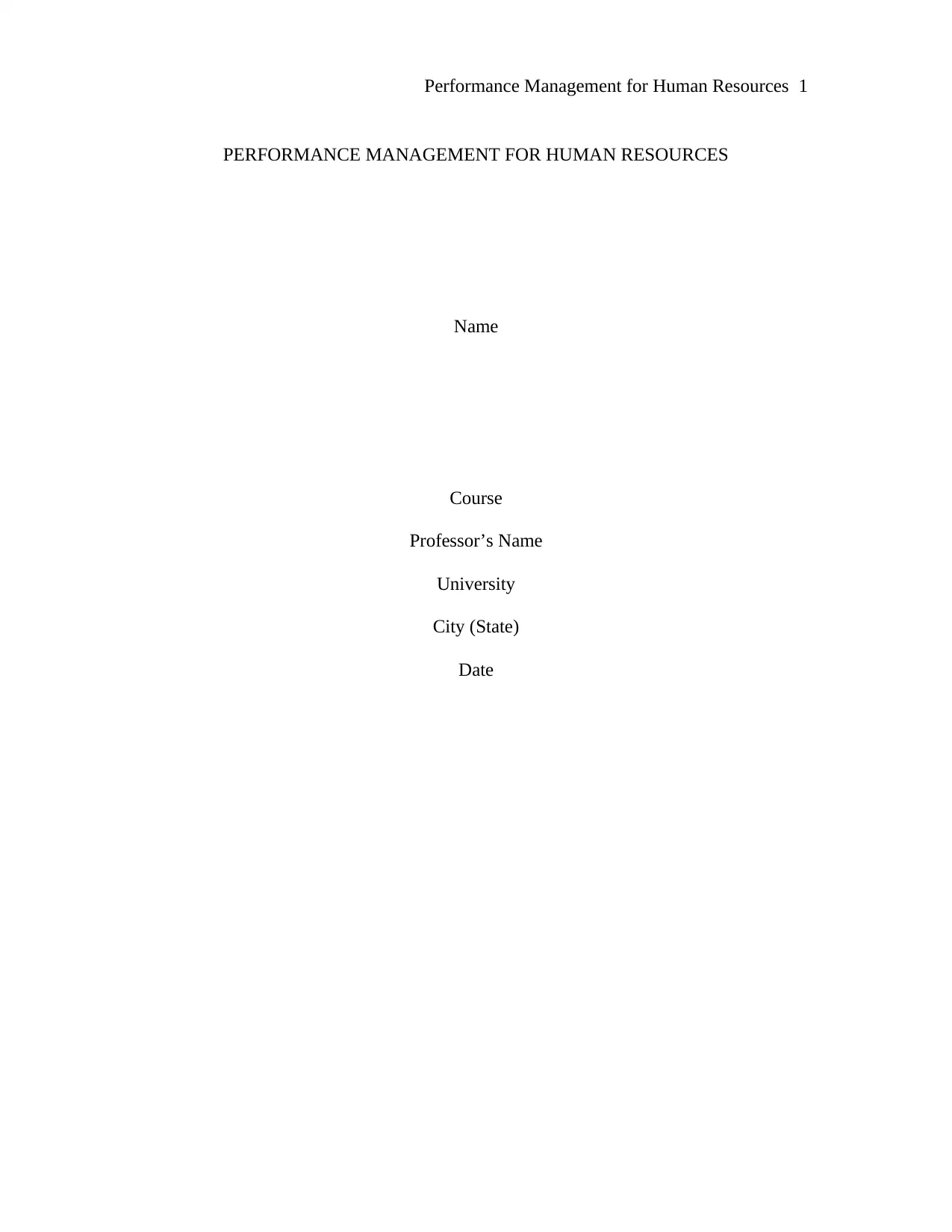
Performance Management for Human Resources 1
PERFORMANCE MANAGEMENT FOR HUMAN RESOURCES
Name
Course
Professor’s Name
University
City (State)
Date
PERFORMANCE MANAGEMENT FOR HUMAN RESOURCES
Name
Course
Professor’s Name
University
City (State)
Date
Paraphrase This Document
Need a fresh take? Get an instant paraphrase of this document with our AI Paraphraser
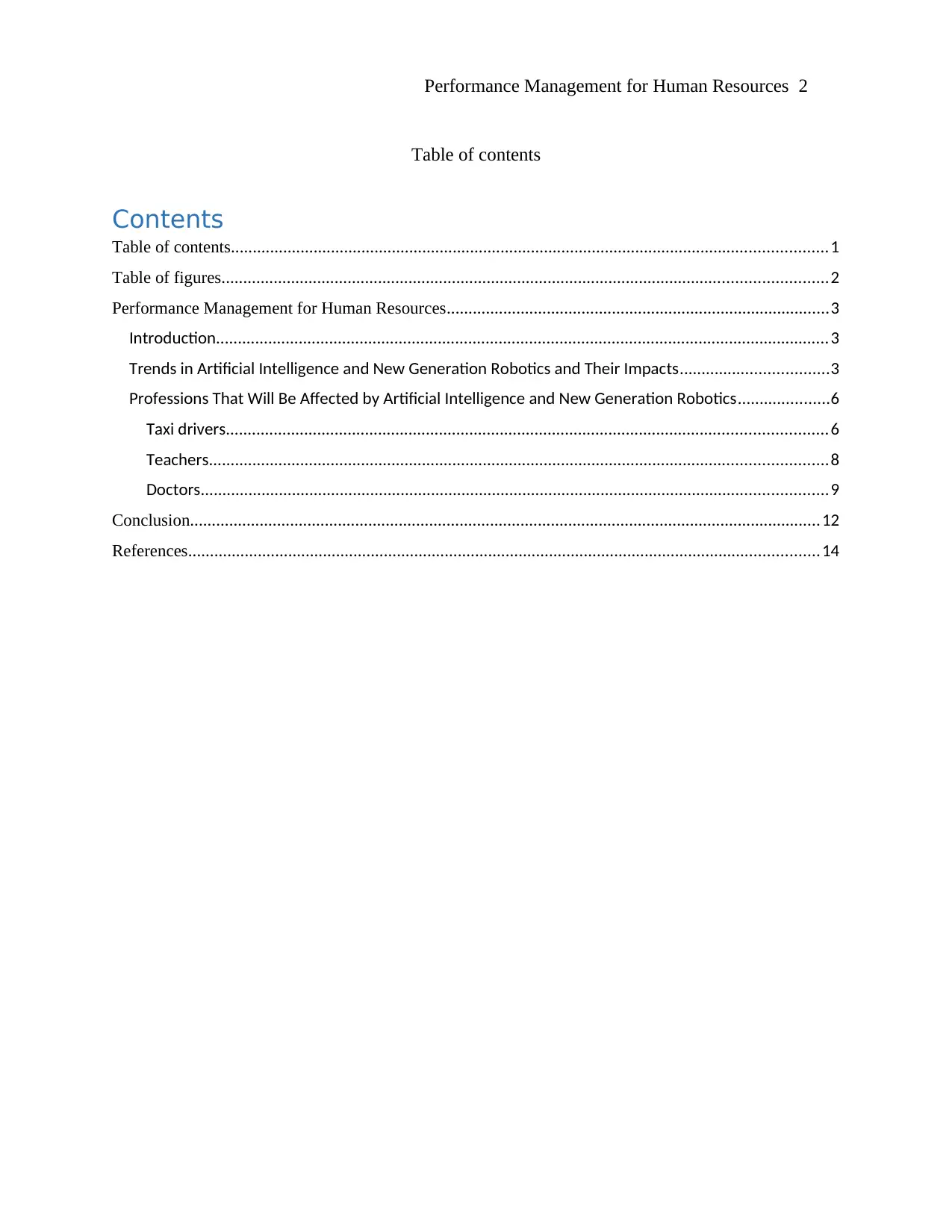
Performance Management for Human Resources 2
Table of contents
Contents
Table of contents.........................................................................................................................................1
Table of figures...........................................................................................................................................2
Performance Management for Human Resources........................................................................................3
Introduction.............................................................................................................................................3
Trends in Artificial Intelligence and New Generation Robotics and Their Impacts..................................3
Professions That Will Be Affected by Artificial Intelligence and New Generation Robotics.....................6
Taxi drivers..........................................................................................................................................6
Teachers..............................................................................................................................................8
Doctors................................................................................................................................................9
Conclusion.................................................................................................................................................12
References.................................................................................................................................................14
Table of contents
Contents
Table of contents.........................................................................................................................................1
Table of figures...........................................................................................................................................2
Performance Management for Human Resources........................................................................................3
Introduction.............................................................................................................................................3
Trends in Artificial Intelligence and New Generation Robotics and Their Impacts..................................3
Professions That Will Be Affected by Artificial Intelligence and New Generation Robotics.....................6
Taxi drivers..........................................................................................................................................6
Teachers..............................................................................................................................................8
Doctors................................................................................................................................................9
Conclusion.................................................................................................................................................12
References.................................................................................................................................................14
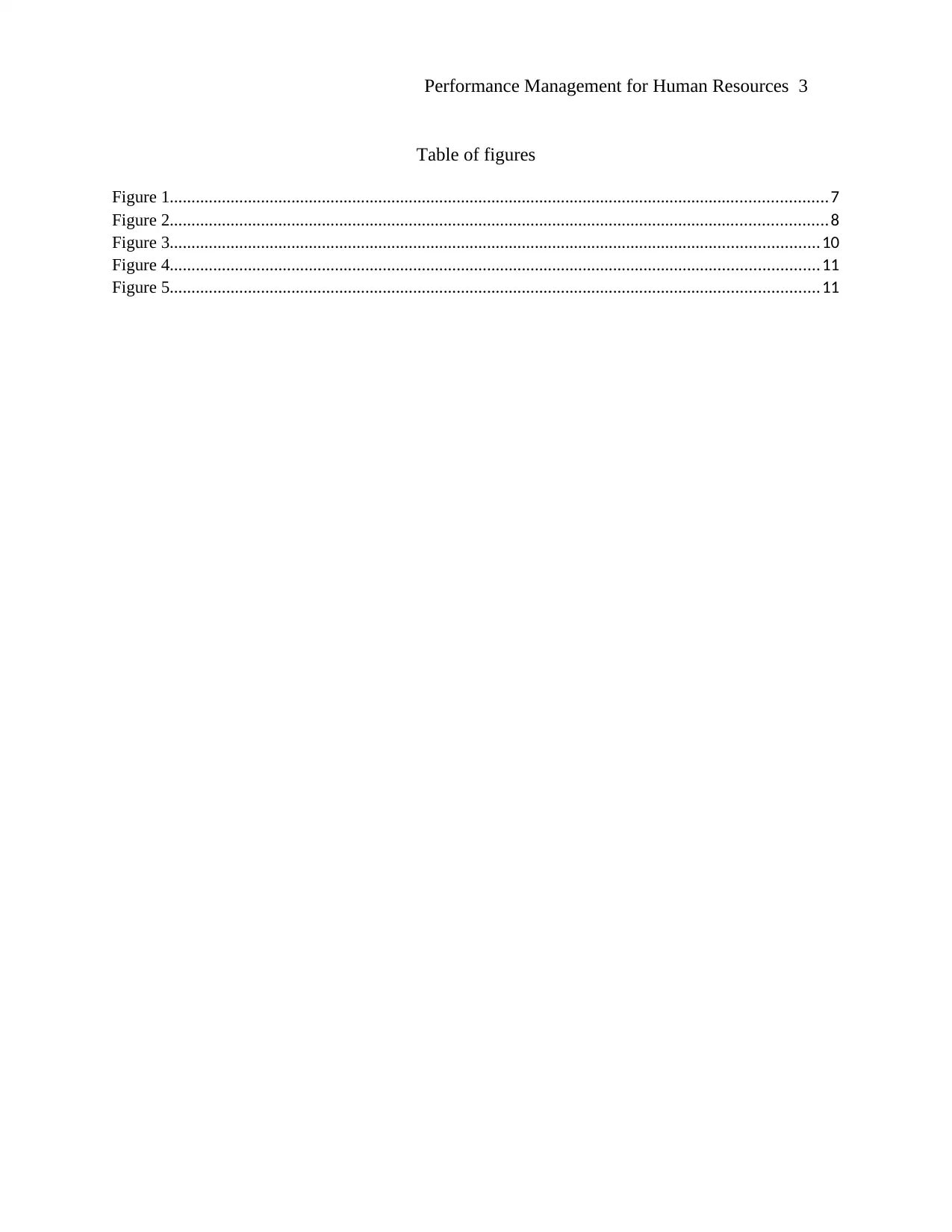
Performance Management for Human Resources 3
Table of figures
Figure 1.......................................................................................................................................................7
Figure 2.......................................................................................................................................................8
Figure 3.....................................................................................................................................................10
Figure 4.....................................................................................................................................................11
Figure 5.....................................................................................................................................................11
Table of figures
Figure 1.......................................................................................................................................................7
Figure 2.......................................................................................................................................................8
Figure 3.....................................................................................................................................................10
Figure 4.....................................................................................................................................................11
Figure 5.....................................................................................................................................................11
⊘ This is a preview!⊘
Do you want full access?
Subscribe today to unlock all pages.

Trusted by 1+ million students worldwide
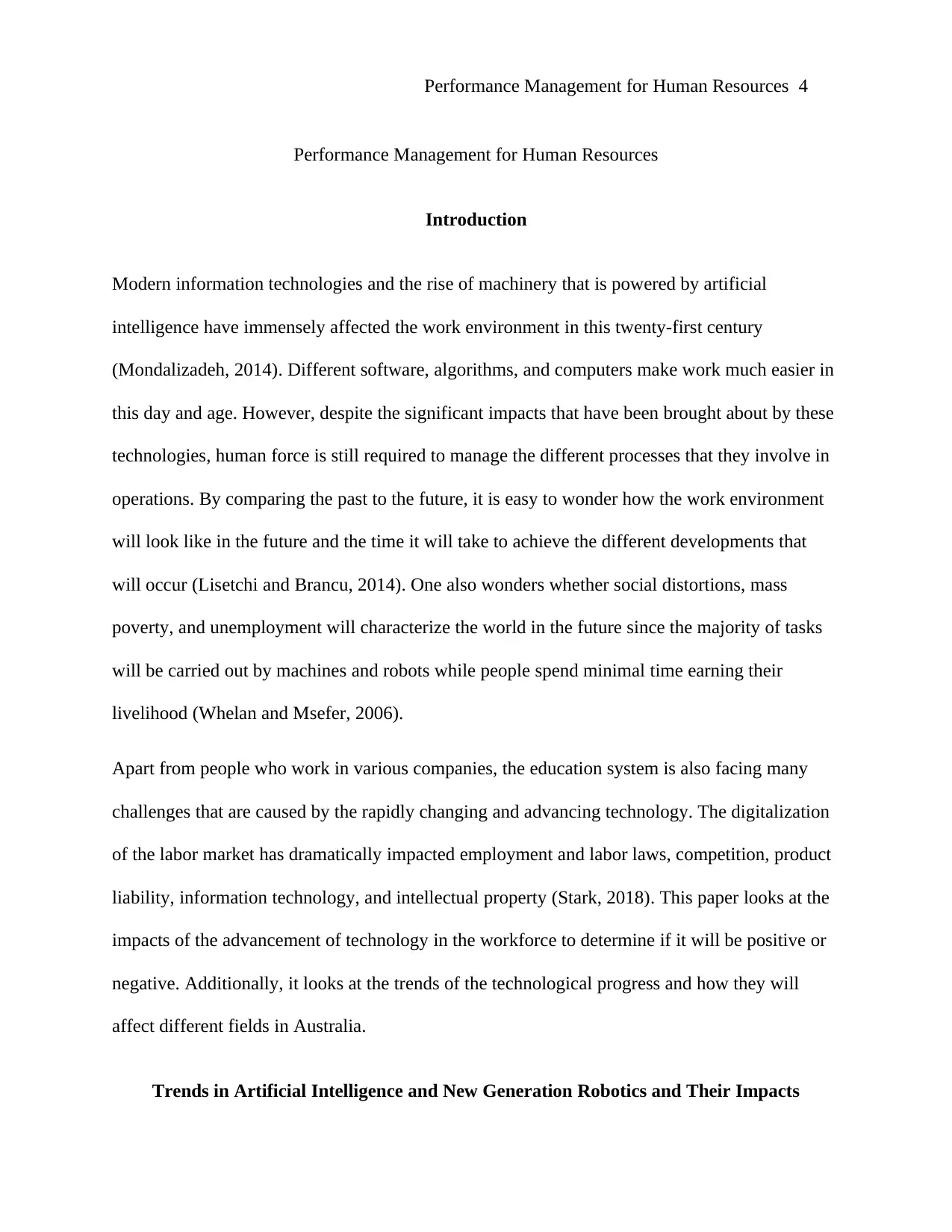
Performance Management for Human Resources 4
Performance Management for Human Resources
Introduction
Modern information technologies and the rise of machinery that is powered by artificial
intelligence have immensely affected the work environment in this twenty-first century
(Mondalizadeh, 2014). Different software, algorithms, and computers make work much easier in
this day and age. However, despite the significant impacts that have been brought about by these
technologies, human force is still required to manage the different processes that they involve in
operations. By comparing the past to the future, it is easy to wonder how the work environment
will look like in the future and the time it will take to achieve the different developments that
will occur (Lisetchi and Brancu, 2014). One also wonders whether social distortions, mass
poverty, and unemployment will characterize the world in the future since the majority of tasks
will be carried out by machines and robots while people spend minimal time earning their
livelihood (Whelan and Msefer, 2006).
Apart from people who work in various companies, the education system is also facing many
challenges that are caused by the rapidly changing and advancing technology. The digitalization
of the labor market has dramatically impacted employment and labor laws, competition, product
liability, information technology, and intellectual property (Stark, 2018). This paper looks at the
impacts of the advancement of technology in the workforce to determine if it will be positive or
negative. Additionally, it looks at the trends of the technological progress and how they will
affect different fields in Australia.
Trends in Artificial Intelligence and New Generation Robotics and Their Impacts
Performance Management for Human Resources
Introduction
Modern information technologies and the rise of machinery that is powered by artificial
intelligence have immensely affected the work environment in this twenty-first century
(Mondalizadeh, 2014). Different software, algorithms, and computers make work much easier in
this day and age. However, despite the significant impacts that have been brought about by these
technologies, human force is still required to manage the different processes that they involve in
operations. By comparing the past to the future, it is easy to wonder how the work environment
will look like in the future and the time it will take to achieve the different developments that
will occur (Lisetchi and Brancu, 2014). One also wonders whether social distortions, mass
poverty, and unemployment will characterize the world in the future since the majority of tasks
will be carried out by machines and robots while people spend minimal time earning their
livelihood (Whelan and Msefer, 2006).
Apart from people who work in various companies, the education system is also facing many
challenges that are caused by the rapidly changing and advancing technology. The digitalization
of the labor market has dramatically impacted employment and labor laws, competition, product
liability, information technology, and intellectual property (Stark, 2018). This paper looks at the
impacts of the advancement of technology in the workforce to determine if it will be positive or
negative. Additionally, it looks at the trends of the technological progress and how they will
affect different fields in Australia.
Trends in Artificial Intelligence and New Generation Robotics and Their Impacts
Paraphrase This Document
Need a fresh take? Get an instant paraphrase of this document with our AI Paraphraser
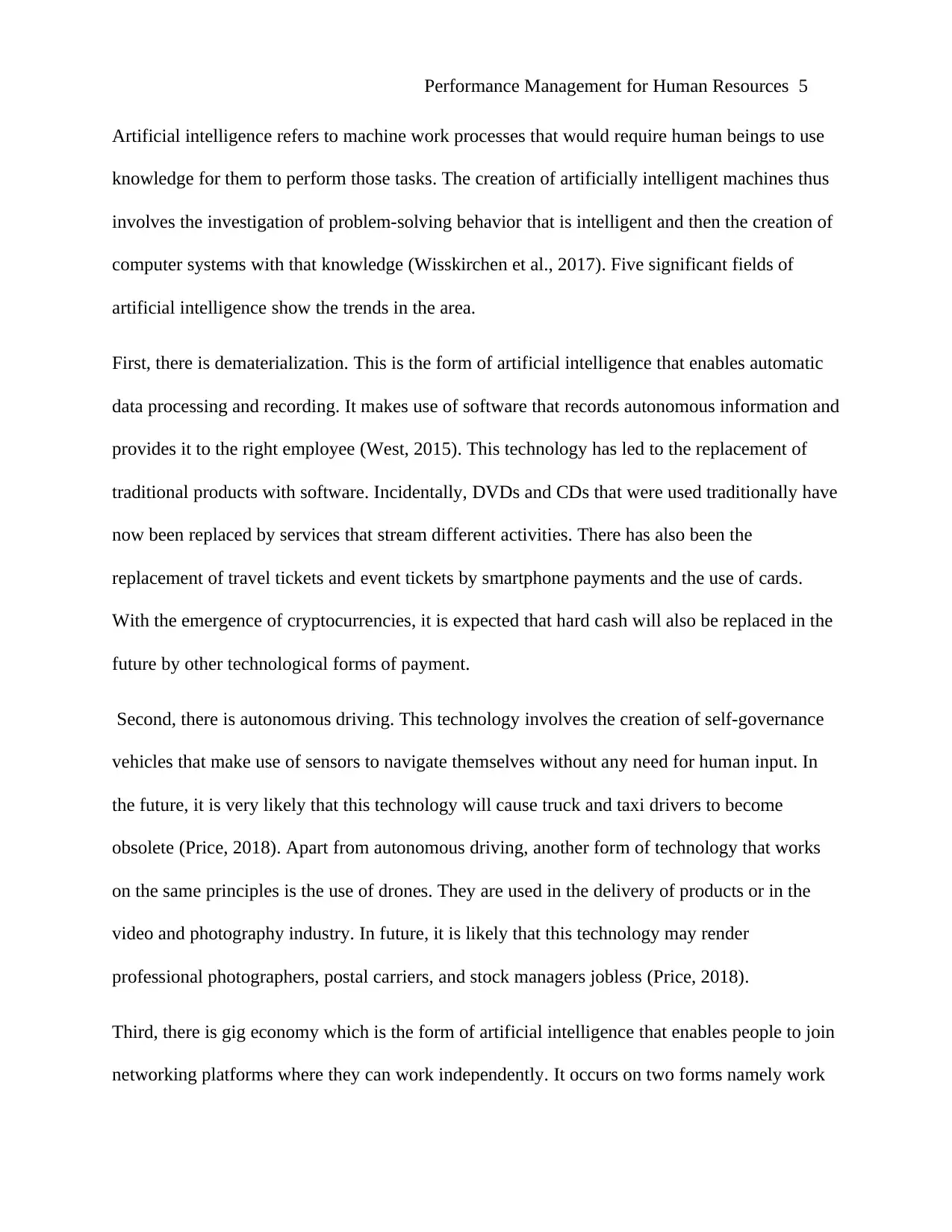
Performance Management for Human Resources 5
Artificial intelligence refers to machine work processes that would require human beings to use
knowledge for them to perform those tasks. The creation of artificially intelligent machines thus
involves the investigation of problem-solving behavior that is intelligent and then the creation of
computer systems with that knowledge (Wisskirchen et al., 2017). Five significant fields of
artificial intelligence show the trends in the area.
First, there is dematerialization. This is the form of artificial intelligence that enables automatic
data processing and recording. It makes use of software that records autonomous information and
provides it to the right employee (West, 2015). This technology has led to the replacement of
traditional products with software. Incidentally, DVDs and CDs that were used traditionally have
now been replaced by services that stream different activities. There has also been the
replacement of travel tickets and event tickets by smartphone payments and the use of cards.
With the emergence of cryptocurrencies, it is expected that hard cash will also be replaced in the
future by other technological forms of payment.
Second, there is autonomous driving. This technology involves the creation of self-governance
vehicles that make use of sensors to navigate themselves without any need for human input. In
the future, it is very likely that this technology will cause truck and taxi drivers to become
obsolete (Price, 2018). Apart from autonomous driving, another form of technology that works
on the same principles is the use of drones. They are used in the delivery of products or in the
video and photography industry. In future, it is likely that this technology may render
professional photographers, postal carriers, and stock managers jobless (Price, 2018).
Third, there is gig economy which is the form of artificial intelligence that enables people to join
networking platforms where they can work independently. It occurs on two forms namely work
Artificial intelligence refers to machine work processes that would require human beings to use
knowledge for them to perform those tasks. The creation of artificially intelligent machines thus
involves the investigation of problem-solving behavior that is intelligent and then the creation of
computer systems with that knowledge (Wisskirchen et al., 2017). Five significant fields of
artificial intelligence show the trends in the area.
First, there is dematerialization. This is the form of artificial intelligence that enables automatic
data processing and recording. It makes use of software that records autonomous information and
provides it to the right employee (West, 2015). This technology has led to the replacement of
traditional products with software. Incidentally, DVDs and CDs that were used traditionally have
now been replaced by services that stream different activities. There has also been the
replacement of travel tickets and event tickets by smartphone payments and the use of cards.
With the emergence of cryptocurrencies, it is expected that hard cash will also be replaced in the
future by other technological forms of payment.
Second, there is autonomous driving. This technology involves the creation of self-governance
vehicles that make use of sensors to navigate themselves without any need for human input. In
the future, it is very likely that this technology will cause truck and taxi drivers to become
obsolete (Price, 2018). Apart from autonomous driving, another form of technology that works
on the same principles is the use of drones. They are used in the delivery of products or in the
video and photography industry. In future, it is likely that this technology may render
professional photographers, postal carriers, and stock managers jobless (Price, 2018).
Third, there is gig economy which is the form of artificial intelligence that enables people to join
networking platforms where they can work independently. It occurs on two forms namely work
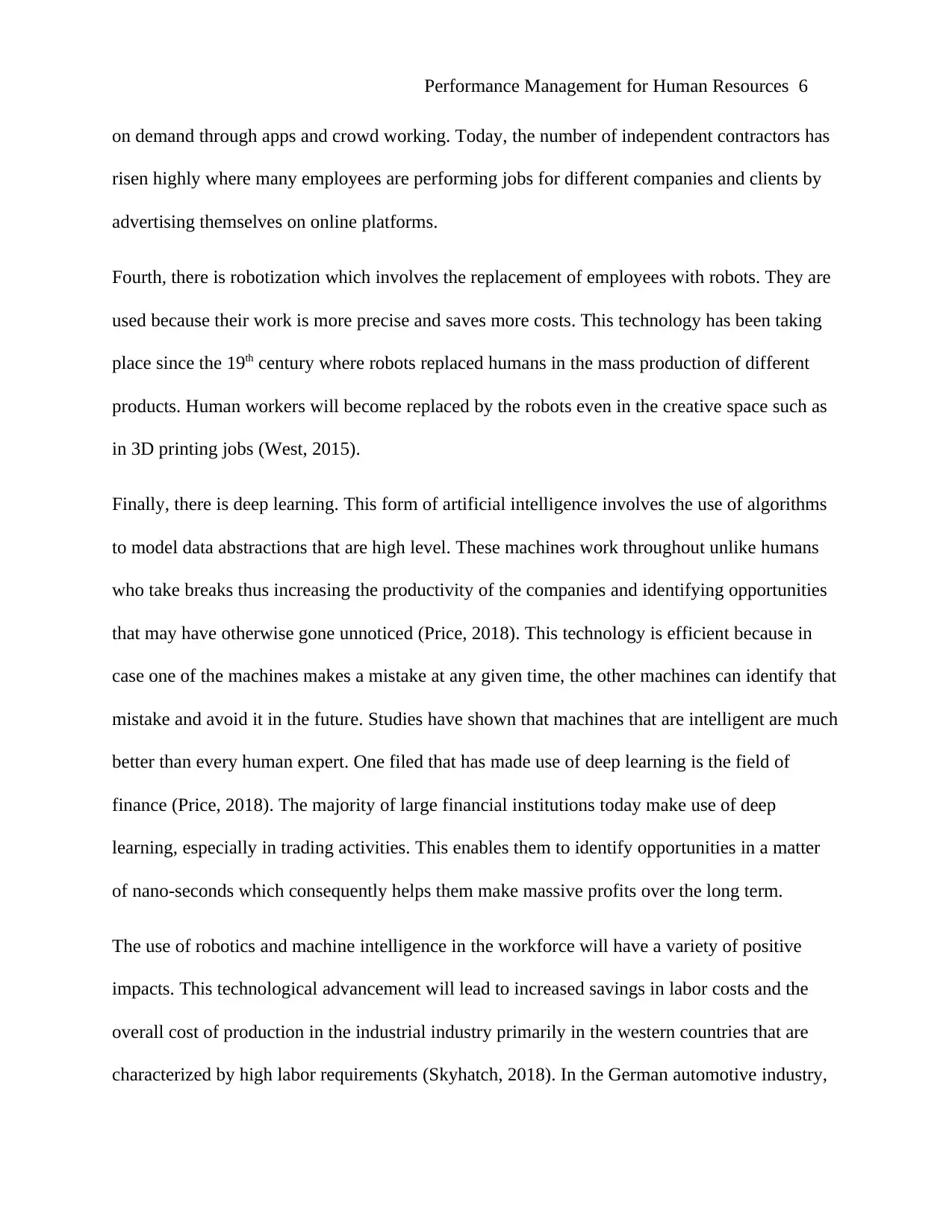
Performance Management for Human Resources 6
on demand through apps and crowd working. Today, the number of independent contractors has
risen highly where many employees are performing jobs for different companies and clients by
advertising themselves on online platforms.
Fourth, there is robotization which involves the replacement of employees with robots. They are
used because their work is more precise and saves more costs. This technology has been taking
place since the 19th century where robots replaced humans in the mass production of different
products. Human workers will become replaced by the robots even in the creative space such as
in 3D printing jobs (West, 2015).
Finally, there is deep learning. This form of artificial intelligence involves the use of algorithms
to model data abstractions that are high level. These machines work throughout unlike humans
who take breaks thus increasing the productivity of the companies and identifying opportunities
that may have otherwise gone unnoticed (Price, 2018). This technology is efficient because in
case one of the machines makes a mistake at any given time, the other machines can identify that
mistake and avoid it in the future. Studies have shown that machines that are intelligent are much
better than every human expert. One filed that has made use of deep learning is the field of
finance (Price, 2018). The majority of large financial institutions today make use of deep
learning, especially in trading activities. This enables them to identify opportunities in a matter
of nano-seconds which consequently helps them make massive profits over the long term.
The use of robotics and machine intelligence in the workforce will have a variety of positive
impacts. This technological advancement will lead to increased savings in labor costs and the
overall cost of production in the industrial industry primarily in the western countries that are
characterized by high labor requirements (Skyhatch, 2018). In the German automotive industry,
on demand through apps and crowd working. Today, the number of independent contractors has
risen highly where many employees are performing jobs for different companies and clients by
advertising themselves on online platforms.
Fourth, there is robotization which involves the replacement of employees with robots. They are
used because their work is more precise and saves more costs. This technology has been taking
place since the 19th century where robots replaced humans in the mass production of different
products. Human workers will become replaced by the robots even in the creative space such as
in 3D printing jobs (West, 2015).
Finally, there is deep learning. This form of artificial intelligence involves the use of algorithms
to model data abstractions that are high level. These machines work throughout unlike humans
who take breaks thus increasing the productivity of the companies and identifying opportunities
that may have otherwise gone unnoticed (Price, 2018). This technology is efficient because in
case one of the machines makes a mistake at any given time, the other machines can identify that
mistake and avoid it in the future. Studies have shown that machines that are intelligent are much
better than every human expert. One filed that has made use of deep learning is the field of
finance (Price, 2018). The majority of large financial institutions today make use of deep
learning, especially in trading activities. This enables them to identify opportunities in a matter
of nano-seconds which consequently helps them make massive profits over the long term.
The use of robotics and machine intelligence in the workforce will have a variety of positive
impacts. This technological advancement will lead to increased savings in labor costs and the
overall cost of production in the industrial industry primarily in the western countries that are
characterized by high labor requirements (Skyhatch, 2018). In the German automotive industry,
⊘ This is a preview!⊘
Do you want full access?
Subscribe today to unlock all pages.

Trusted by 1+ million students worldwide
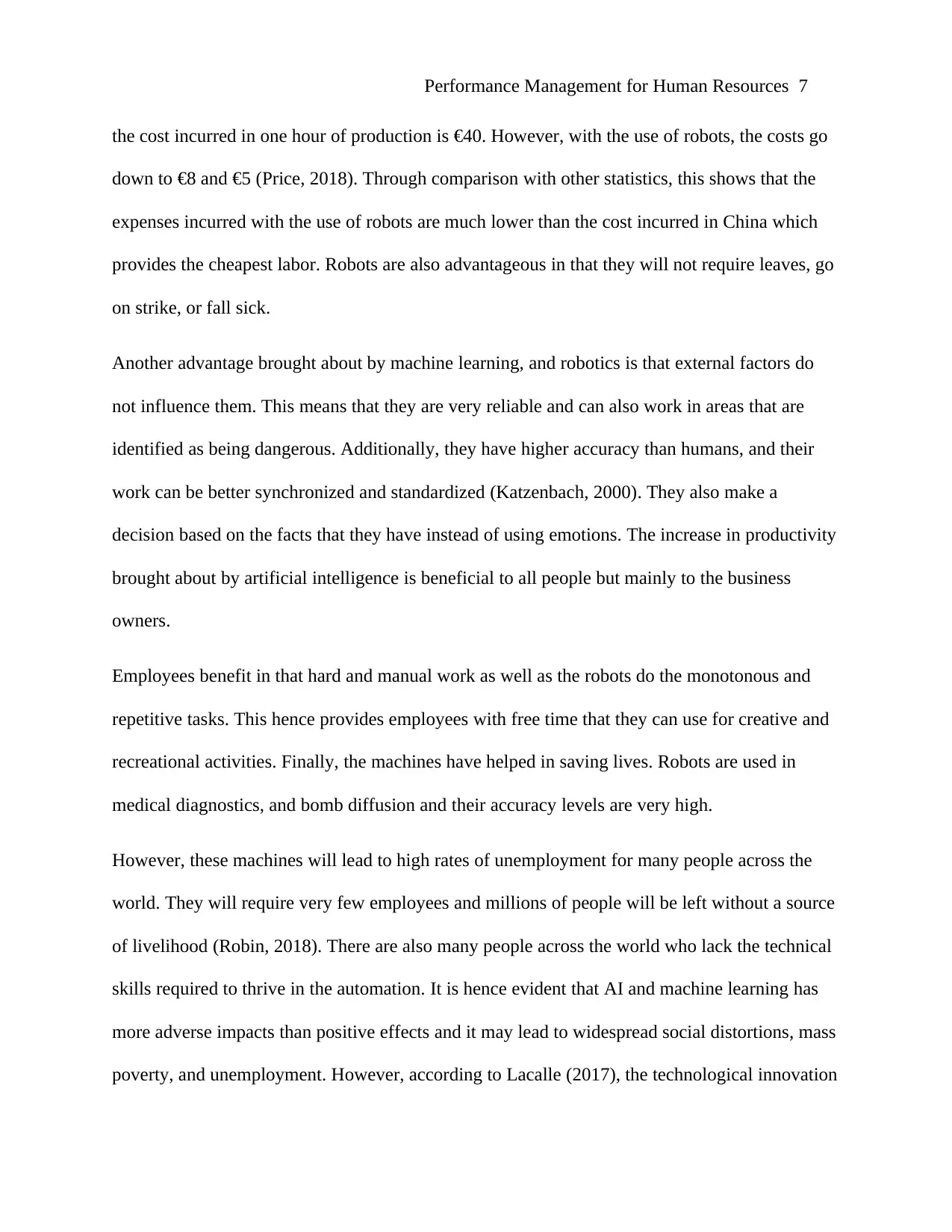
Performance Management for Human Resources 7
the cost incurred in one hour of production is €40. However, with the use of robots, the costs go
down to €8 and €5 (Price, 2018). Through comparison with other statistics, this shows that the
expenses incurred with the use of robots are much lower than the cost incurred in China which
provides the cheapest labor. Robots are also advantageous in that they will not require leaves, go
on strike, or fall sick.
Another advantage brought about by machine learning, and robotics is that external factors do
not influence them. This means that they are very reliable and can also work in areas that are
identified as being dangerous. Additionally, they have higher accuracy than humans, and their
work can be better synchronized and standardized (Katzenbach, 2000). They also make a
decision based on the facts that they have instead of using emotions. The increase in productivity
brought about by artificial intelligence is beneficial to all people but mainly to the business
owners.
Employees benefit in that hard and manual work as well as the robots do the monotonous and
repetitive tasks. This hence provides employees with free time that they can use for creative and
recreational activities. Finally, the machines have helped in saving lives. Robots are used in
medical diagnostics, and bomb diffusion and their accuracy levels are very high.
However, these machines will lead to high rates of unemployment for many people across the
world. They will require very few employees and millions of people will be left without a source
of livelihood (Robin, 2018). There are also many people across the world who lack the technical
skills required to thrive in the automation. It is hence evident that AI and machine learning has
more adverse impacts than positive effects and it may lead to widespread social distortions, mass
poverty, and unemployment. However, according to Lacalle (2017), the technological innovation
the cost incurred in one hour of production is €40. However, with the use of robots, the costs go
down to €8 and €5 (Price, 2018). Through comparison with other statistics, this shows that the
expenses incurred with the use of robots are much lower than the cost incurred in China which
provides the cheapest labor. Robots are also advantageous in that they will not require leaves, go
on strike, or fall sick.
Another advantage brought about by machine learning, and robotics is that external factors do
not influence them. This means that they are very reliable and can also work in areas that are
identified as being dangerous. Additionally, they have higher accuracy than humans, and their
work can be better synchronized and standardized (Katzenbach, 2000). They also make a
decision based on the facts that they have instead of using emotions. The increase in productivity
brought about by artificial intelligence is beneficial to all people but mainly to the business
owners.
Employees benefit in that hard and manual work as well as the robots do the monotonous and
repetitive tasks. This hence provides employees with free time that they can use for creative and
recreational activities. Finally, the machines have helped in saving lives. Robots are used in
medical diagnostics, and bomb diffusion and their accuracy levels are very high.
However, these machines will lead to high rates of unemployment for many people across the
world. They will require very few employees and millions of people will be left without a source
of livelihood (Robin, 2018). There are also many people across the world who lack the technical
skills required to thrive in the automation. It is hence evident that AI and machine learning has
more adverse impacts than positive effects and it may lead to widespread social distortions, mass
poverty, and unemployment. However, according to Lacalle (2017), the technological innovation
Paraphrase This Document
Need a fresh take? Get an instant paraphrase of this document with our AI Paraphraser
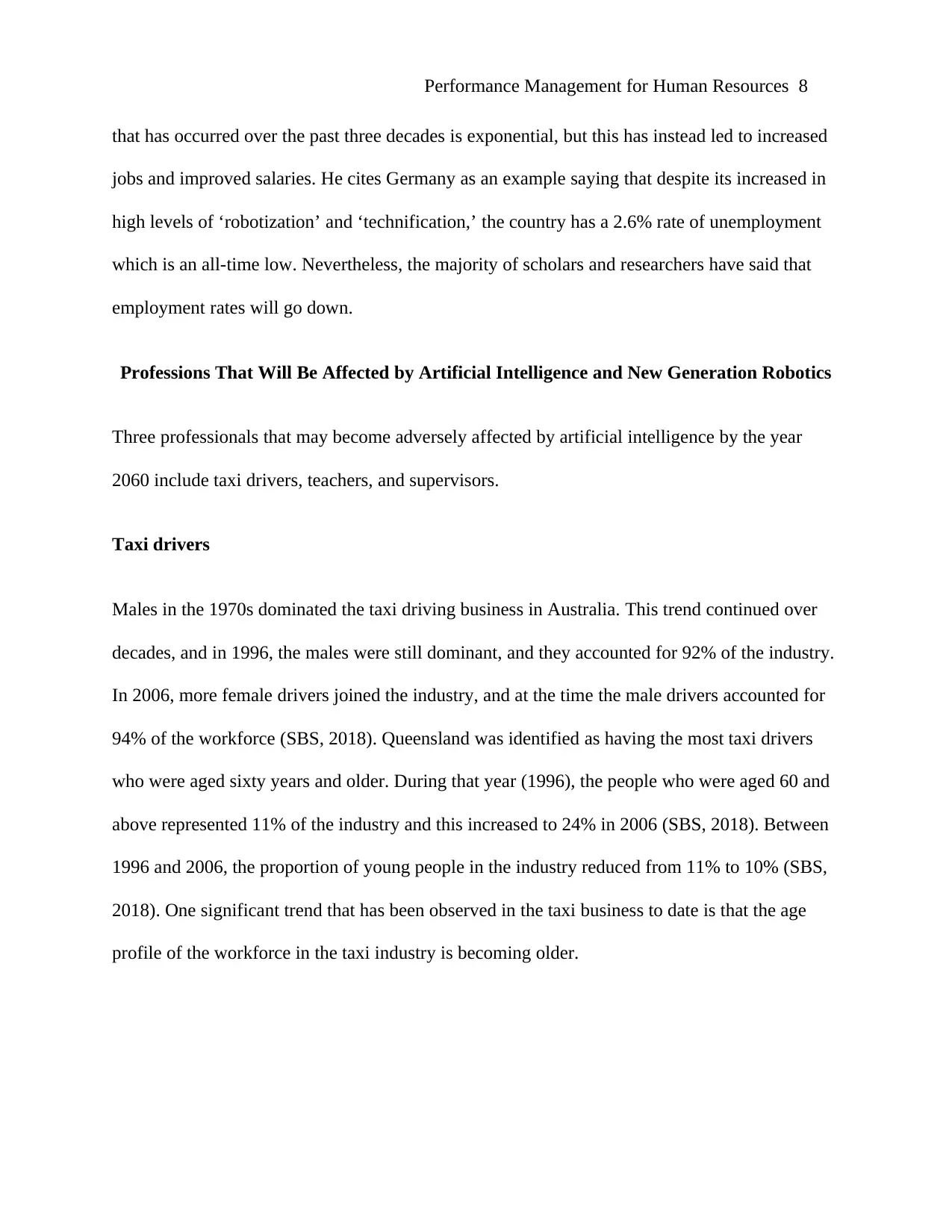
Performance Management for Human Resources 8
that has occurred over the past three decades is exponential, but this has instead led to increased
jobs and improved salaries. He cites Germany as an example saying that despite its increased in
high levels of ‘robotization’ and ‘technification,’ the country has a 2.6% rate of unemployment
which is an all-time low. Nevertheless, the majority of scholars and researchers have said that
employment rates will go down.
Professions That Will Be Affected by Artificial Intelligence and New Generation Robotics
Three professionals that may become adversely affected by artificial intelligence by the year
2060 include taxi drivers, teachers, and supervisors.
Taxi drivers
Males in the 1970s dominated the taxi driving business in Australia. This trend continued over
decades, and in 1996, the males were still dominant, and they accounted for 92% of the industry.
In 2006, more female drivers joined the industry, and at the time the male drivers accounted for
94% of the workforce (SBS, 2018). Queensland was identified as having the most taxi drivers
who were aged sixty years and older. During that year (1996), the people who were aged 60 and
above represented 11% of the industry and this increased to 24% in 2006 (SBS, 2018). Between
1996 and 2006, the proportion of young people in the industry reduced from 11% to 10% (SBS,
2018). One significant trend that has been observed in the taxi business to date is that the age
profile of the workforce in the taxi industry is becoming older.
that has occurred over the past three decades is exponential, but this has instead led to increased
jobs and improved salaries. He cites Germany as an example saying that despite its increased in
high levels of ‘robotization’ and ‘technification,’ the country has a 2.6% rate of unemployment
which is an all-time low. Nevertheless, the majority of scholars and researchers have said that
employment rates will go down.
Professions That Will Be Affected by Artificial Intelligence and New Generation Robotics
Three professionals that may become adversely affected by artificial intelligence by the year
2060 include taxi drivers, teachers, and supervisors.
Taxi drivers
Males in the 1970s dominated the taxi driving business in Australia. This trend continued over
decades, and in 1996, the males were still dominant, and they accounted for 92% of the industry.
In 2006, more female drivers joined the industry, and at the time the male drivers accounted for
94% of the workforce (SBS, 2018). Queensland was identified as having the most taxi drivers
who were aged sixty years and older. During that year (1996), the people who were aged 60 and
above represented 11% of the industry and this increased to 24% in 2006 (SBS, 2018). Between
1996 and 2006, the proportion of young people in the industry reduced from 11% to 10% (SBS,
2018). One significant trend that has been observed in the taxi business to date is that the age
profile of the workforce in the taxi industry is becoming older.
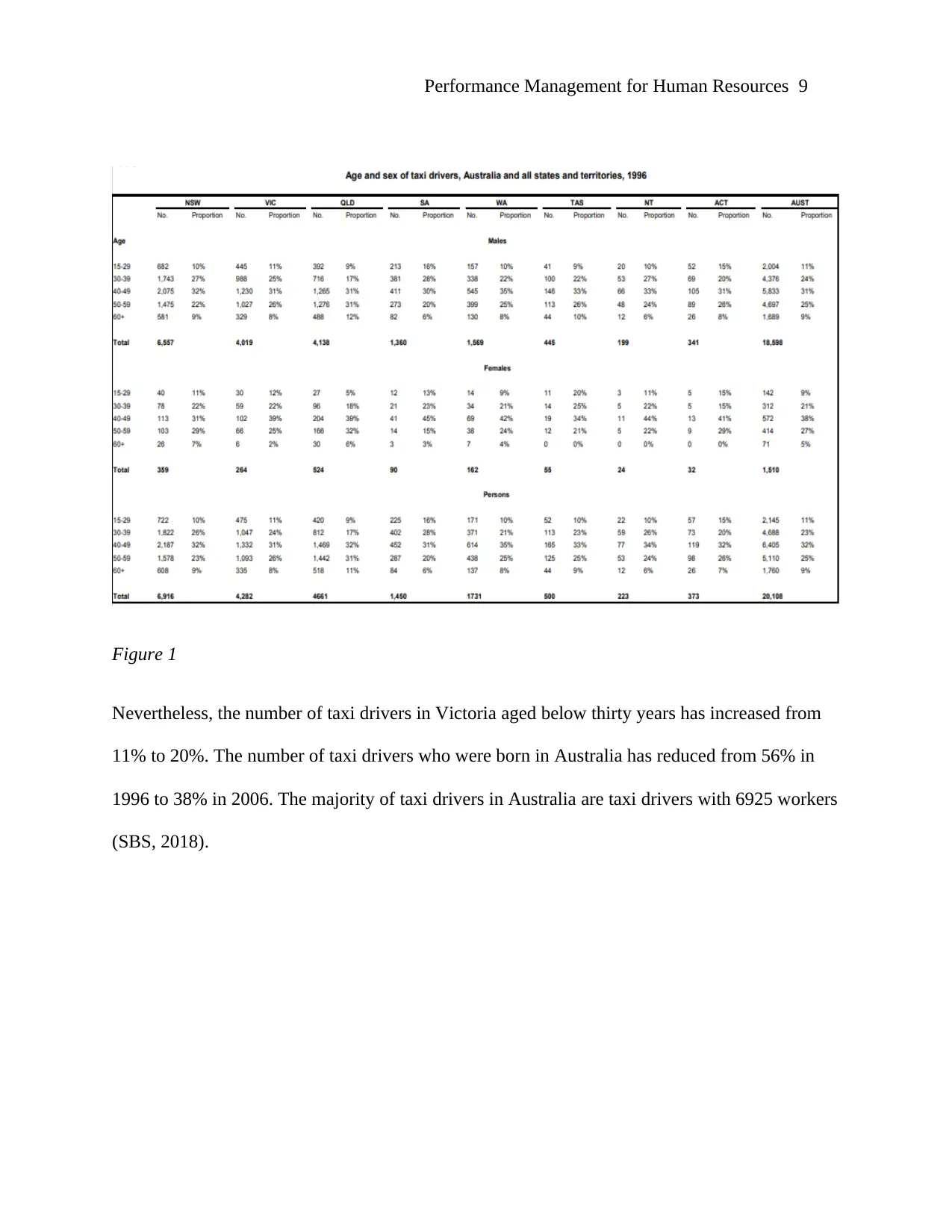
Performance Management for Human Resources 9
Figure 1
Nevertheless, the number of taxi drivers in Victoria aged below thirty years has increased from
11% to 20%. The number of taxi drivers who were born in Australia has reduced from 56% in
1996 to 38% in 2006. The majority of taxi drivers in Australia are taxi drivers with 6925 workers
(SBS, 2018).
Figure 1
Nevertheless, the number of taxi drivers in Victoria aged below thirty years has increased from
11% to 20%. The number of taxi drivers who were born in Australia has reduced from 56% in
1996 to 38% in 2006. The majority of taxi drivers in Australia are taxi drivers with 6925 workers
(SBS, 2018).
⊘ This is a preview!⊘
Do you want full access?
Subscribe today to unlock all pages.

Trusted by 1+ million students worldwide
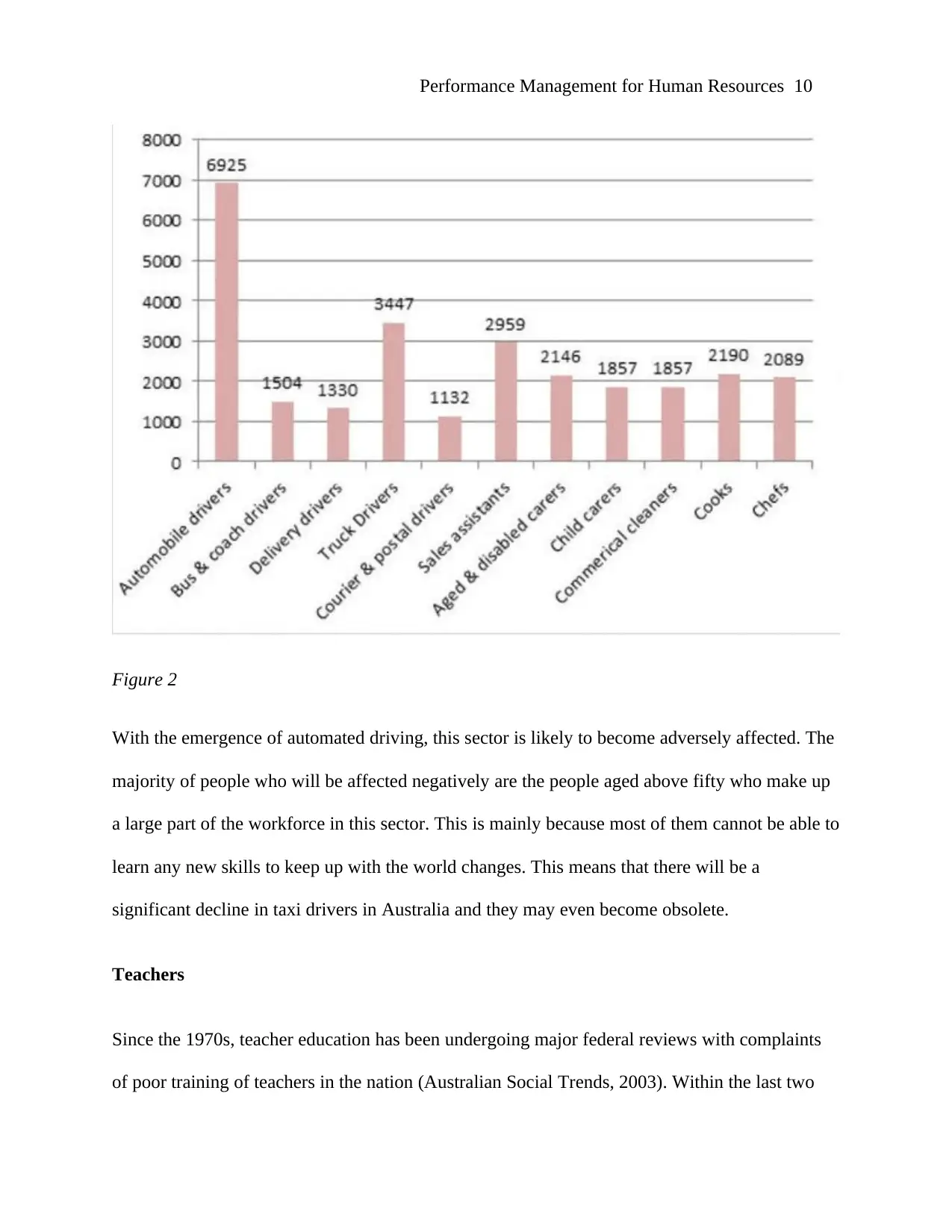
Performance Management for Human Resources 10
Figure 2
With the emergence of automated driving, this sector is likely to become adversely affected. The
majority of people who will be affected negatively are the people aged above fifty who make up
a large part of the workforce in this sector. This is mainly because most of them cannot be able to
learn any new skills to keep up with the world changes. This means that there will be a
significant decline in taxi drivers in Australia and they may even become obsolete.
Teachers
Since the 1970s, teacher education has been undergoing major federal reviews with complaints
of poor training of teachers in the nation (Australian Social Trends, 2003). Within the last two
Figure 2
With the emergence of automated driving, this sector is likely to become adversely affected. The
majority of people who will be affected negatively are the people aged above fifty who make up
a large part of the workforce in this sector. This is mainly because most of them cannot be able to
learn any new skills to keep up with the world changes. This means that there will be a
significant decline in taxi drivers in Australia and they may even become obsolete.
Teachers
Since the 1970s, teacher education has been undergoing major federal reviews with complaints
of poor training of teachers in the nation (Australian Social Trends, 2003). Within the last two
Paraphrase This Document
Need a fresh take? Get an instant paraphrase of this document with our AI Paraphraser
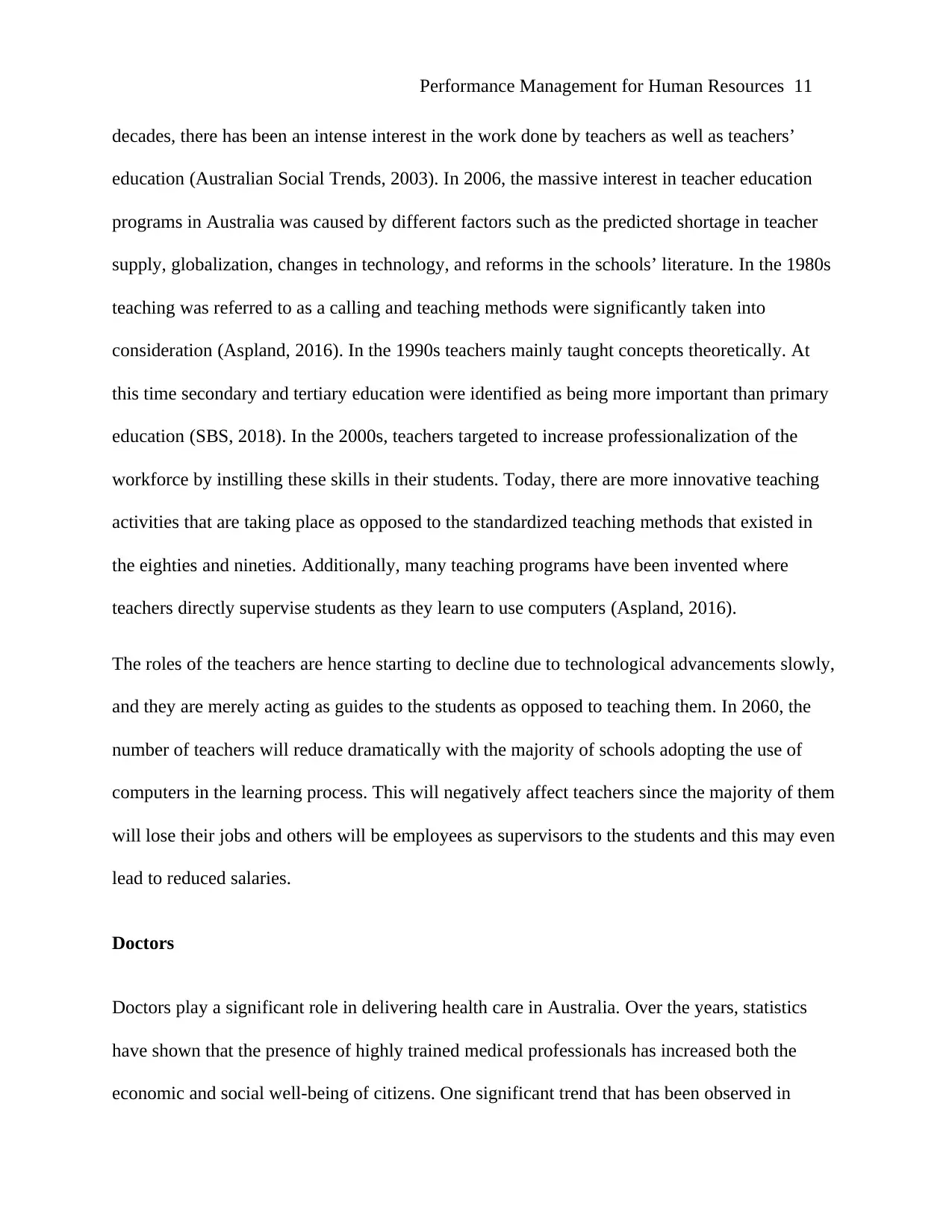
Performance Management for Human Resources 11
decades, there has been an intense interest in the work done by teachers as well as teachers’
education (Australian Social Trends, 2003). In 2006, the massive interest in teacher education
programs in Australia was caused by different factors such as the predicted shortage in teacher
supply, globalization, changes in technology, and reforms in the schools’ literature. In the 1980s
teaching was referred to as a calling and teaching methods were significantly taken into
consideration (Aspland, 2016). In the 1990s teachers mainly taught concepts theoretically. At
this time secondary and tertiary education were identified as being more important than primary
education (SBS, 2018). In the 2000s, teachers targeted to increase professionalization of the
workforce by instilling these skills in their students. Today, there are more innovative teaching
activities that are taking place as opposed to the standardized teaching methods that existed in
the eighties and nineties. Additionally, many teaching programs have been invented where
teachers directly supervise students as they learn to use computers (Aspland, 2016).
The roles of the teachers are hence starting to decline due to technological advancements slowly,
and they are merely acting as guides to the students as opposed to teaching them. In 2060, the
number of teachers will reduce dramatically with the majority of schools adopting the use of
computers in the learning process. This will negatively affect teachers since the majority of them
will lose their jobs and others will be employees as supervisors to the students and this may even
lead to reduced salaries.
Doctors
Doctors play a significant role in delivering health care in Australia. Over the years, statistics
have shown that the presence of highly trained medical professionals has increased both the
economic and social well-being of citizens. One significant trend that has been observed in
decades, there has been an intense interest in the work done by teachers as well as teachers’
education (Australian Social Trends, 2003). In 2006, the massive interest in teacher education
programs in Australia was caused by different factors such as the predicted shortage in teacher
supply, globalization, changes in technology, and reforms in the schools’ literature. In the 1980s
teaching was referred to as a calling and teaching methods were significantly taken into
consideration (Aspland, 2016). In the 1990s teachers mainly taught concepts theoretically. At
this time secondary and tertiary education were identified as being more important than primary
education (SBS, 2018). In the 2000s, teachers targeted to increase professionalization of the
workforce by instilling these skills in their students. Today, there are more innovative teaching
activities that are taking place as opposed to the standardized teaching methods that existed in
the eighties and nineties. Additionally, many teaching programs have been invented where
teachers directly supervise students as they learn to use computers (Aspland, 2016).
The roles of the teachers are hence starting to decline due to technological advancements slowly,
and they are merely acting as guides to the students as opposed to teaching them. In 2060, the
number of teachers will reduce dramatically with the majority of schools adopting the use of
computers in the learning process. This will negatively affect teachers since the majority of them
will lose their jobs and others will be employees as supervisors to the students and this may even
lead to reduced salaries.
Doctors
Doctors play a significant role in delivering health care in Australia. Over the years, statistics
have shown that the presence of highly trained medical professionals has increased both the
economic and social well-being of citizens. One significant trend that has been observed in
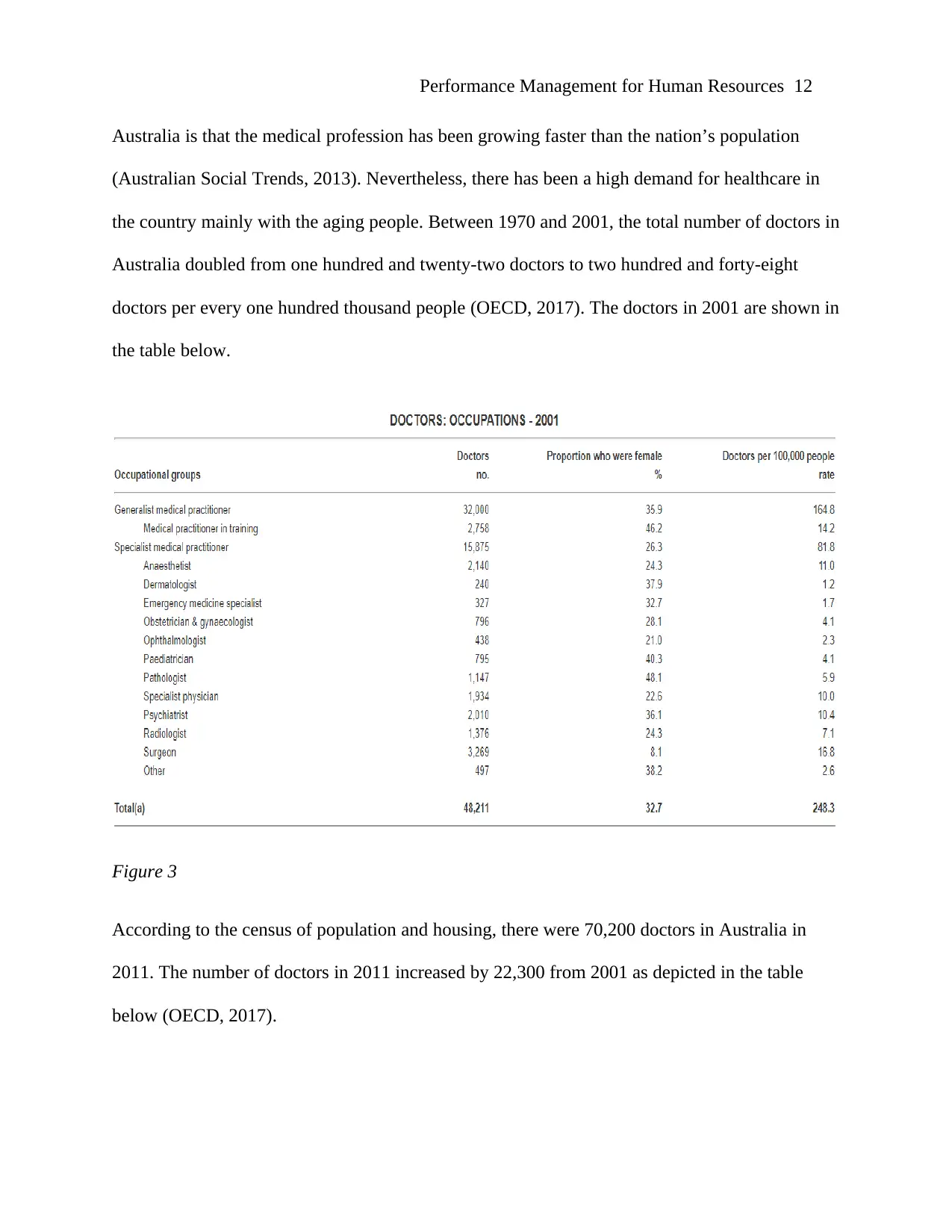
Performance Management for Human Resources 12
Australia is that the medical profession has been growing faster than the nation’s population
(Australian Social Trends, 2013). Nevertheless, there has been a high demand for healthcare in
the country mainly with the aging people. Between 1970 and 2001, the total number of doctors in
Australia doubled from one hundred and twenty-two doctors to two hundred and forty-eight
doctors per every one hundred thousand people (OECD, 2017). The doctors in 2001 are shown in
the table below.
Figure 3
According to the census of population and housing, there were 70,200 doctors in Australia in
2011. The number of doctors in 2011 increased by 22,300 from 2001 as depicted in the table
below (OECD, 2017).
Australia is that the medical profession has been growing faster than the nation’s population
(Australian Social Trends, 2013). Nevertheless, there has been a high demand for healthcare in
the country mainly with the aging people. Between 1970 and 2001, the total number of doctors in
Australia doubled from one hundred and twenty-two doctors to two hundred and forty-eight
doctors per every one hundred thousand people (OECD, 2017). The doctors in 2001 are shown in
the table below.
Figure 3
According to the census of population and housing, there were 70,200 doctors in Australia in
2011. The number of doctors in 2011 increased by 22,300 from 2001 as depicted in the table
below (OECD, 2017).
⊘ This is a preview!⊘
Do you want full access?
Subscribe today to unlock all pages.

Trusted by 1+ million students worldwide
1 out of 18
Related Documents
Your All-in-One AI-Powered Toolkit for Academic Success.
+13062052269
info@desklib.com
Available 24*7 on WhatsApp / Email
![[object Object]](/_next/static/media/star-bottom.7253800d.svg)
Unlock your academic potential
Copyright © 2020–2025 A2Z Services. All Rights Reserved. Developed and managed by ZUCOL.





